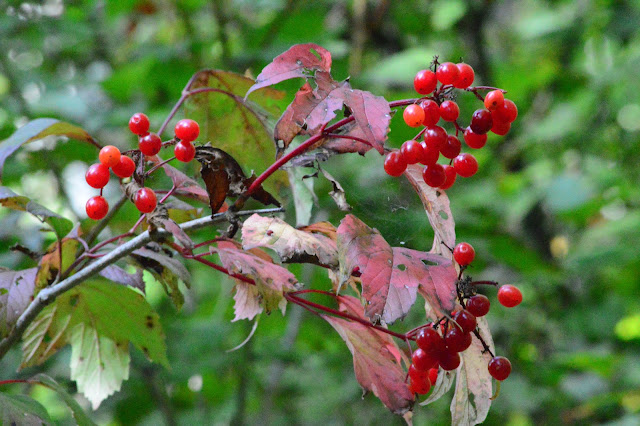Chokecherry season is in full swing these days in the Upper Peninsula. The bushes and trees are just loaded. Chokecherries grow on bushes as small as three feet or on trees that can grow up to twenty feet.
The cherries start out a bright red then gradually turn to a deep purplish dark red color. Don't mistake these for red cherries. Chokecherries have a high acid content and are very sour. The more ripe they get, the less sour, but still sour!
Though I mentioned they make you pucker, I did read that people make jam, jelly, syrup and even wine with them. But do your research thoroughly! Chokecherries have a small pit inside that contains cyanide. However, so do apple seeds, and the pits in peaches, pears, plums and apricots. Chokecherry leaves and bark are also poisonous if ingested.
Apparently, if you cook the cherries down, it makes the cherry less sour and eliminates the cyanide. I, for one, am not yet ready to try these berries or include them in my recipes. But I will tell you just who loves them and eats them right from the tree.
Steve and I were headed into town the other evening and at the edge of town by the railroad tracks Steve spotted this bear foraging for chokecherries. Bear can do damage on a chokecherry tree as they bend and break the branches to get to their delicious treat. We've found bear scat on the gravel roads full of chokecherry seeds. (So I guess the bear doesn't always "do his/her business" in the woods.) ~Chuckle~
Chokecherries don't affect animals and birds the way they do humans. The sourness doesn't bother them. Almost any animal or bird or even a butterfly will try a chokecherry. One time I was sitting in my deer blind during hunting season and jumped at the sight and the noise of a grouse landing in a chokecherry tree located right next to my blind. I enjoyed the show of watching him eat the chokecherries!
Farms and ranches prefer their pastures to be chokecherry free. Horses love the chokecherry leaves especially in the Fall when they begin to wilt. Too many leaves can be lethal to the horse.
In the Spring, you can identify a chokecherry tree by its cluster of creamy white flowers. Also in the Spring, the trees and bushes attract tent caterpillars. I'm not a fan of them.
But for now, if you're out and about on a Fall walk, look for the clusters of red and purplish blue cherries and you just might find yourself a chokecherry tree!






No comments:
Post a Comment
Thank you for taking the time to comment :)